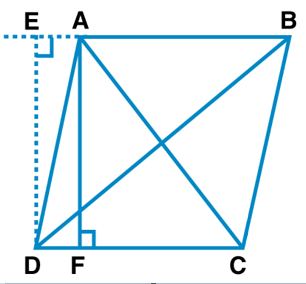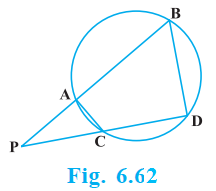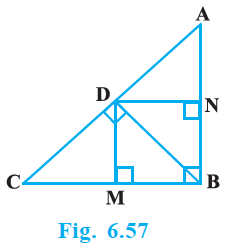Let us consider, ABCD be a parallelogram. Now, draw perpendicular DE on extended side of AB, and draw a perpendicular AF meeting DC at point F.

By applying Pythagoras Theorem in ∆DEA, we get,
$DE^2 + EA^2 = DA^2 $……………….… (i)
By applying Pythagoras Theorem in ∆DEB, we get,
$DE^2 + EB^2 = DB^2$
$DE^2 + (EA + AB)^2 = DB^2$
$(DE^2 + EA^2) + AB^2 + 2EA × AB = DB^2$
$DA^2 + AB^2 + 2EA × AB = DB^2$ ……………. (ii)
By applying Pythagoras Theorem in ∆ADF, we get,
$AD^2 = AF^2 + FD^2$
Again, applying Pythagoras theorem in ∆AFC, we get,
$AC^2 = AF^2 + FC^2 = AF^2 + (DC − FD)^2$
$= AF^2 + DC^2 + FD^2 − 2DC × FD$
$= (AF^2 + FD^2) + DC^2 − 2DC × FD AC^2$
$AC^2= AD^2 + DC^2 − 2DC × FD$ ………………… (iii)
Since ABCD is a parallelogram,
AB = CD ………………….…(iv)
And BC = AD ………………. (v)
In ∆DEA and ∆ADF,
$\angle DEA = \angle AFD$ (Each 90°)
$\angle EAD = \angle ADF (EA || DF)$
AD = AD (Common Angles)
∆EAD ≅ ∆FDA (AAS congruence criterion)
EA = DF ……………… (vi)
Adding equations (i) and (iii), we get,
$DA^2 + AB^2 + 2EA × AB + AD^2 + DC^2 − 2DC × FD = DB^2 + AC^2$
$DA^2 + AB^2 + AD^2 + DC^2 + 2EA × AB − 2DC × FD = DB^2 + AC^2$
From equation (iv) and (vi),
$BC^2 + AB^2 + AD^2 + DC^2 + 2EA × AB − 2AB × EA = DB^2 + AC^2$
$AB^2 + BC^2 + CD^2 + DA^2 = AC^2 + BD^2$









